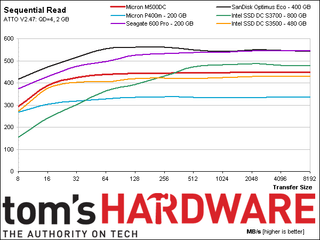Micron M500DC 800 GB SSD Review: Cloud And Web 2.0 Storage
Building on the desktop-oriented M500, Micron is announcing its enterprise-focused M500DC. We got a chance to run the 800 GB model through an updated test suite to gauge whether this Marvell-powered SSD keeps up with the best-known enterprise solutions.
Results: Sequential Performance

Once again, the M500DC posts modest, but not great read performance. At 450 MB/s, it trails SanDisk's Optimus Eco and Seagate's 600 Pro by nearly 100 MB/s.

Sequential write performance is a bit worse. At 405 MB/s, the M500DC consistently beats its specification. But that still puts it near the bottom of the field. It's also nowhere near the Eco's crazy 560 MB/s.
Clearly, sequential performance is not one of the M500DC's strong suits. Fine-tuning SSD firmware is a series of give and takes. Bolstering throughput in one measurement often decreases it in another one. Fortunately, Micron is clear about the workloads this new drive is intended to address. While it excels in a number of enterprise-oriented tasks, the best we can say about the M500DC in sequential transfers is that it's adequate.
Stay on the Cutting Edge
Join the experts who read Tom's Hardware for the inside track on enthusiast PC tech news — and have for over 25 years. We'll send breaking news and in-depth reviews of CPUs, GPUs, AI, maker hardware and more straight to your inbox.
Current page: Results: Sequential Performance
Prev Page Results: Enterprise Workload Performance Next Page Results: Enterprise Video Streaming Performance-
ParrLeyne Good article/review!Reply
Only one _small_ problem. According to the Micron product page (http://www.micron.com/products/solid-state-storage/enterprise-sata-ssd/m500dc-enterprise-sata-ssd) the M500DC is a SATA device, not SAS! -
tripleX The author obviously does not understand the subject matter. SAS lumped in with SATA? read-centric SSD isnt meant for read workloads? etc. numerous errors, too many to list.Reply -
tripleX Author does not understand what "corner case" is. corner case testing? are you doing lab validation work?Reply -
drewriley In SSD testing, it is common to call the mix in testing between read/write and random/sequential as '4 corner' or 'corner case' testing. And yes, this is lab verification work, that is kind of the point of the review. Also, SAS and SATA do compete for applications. The point was to put different product that had similar specifications against one another.Reply -
tripleX Reply13279486 said:In SSD testing, it is common to call the mix in testing between read/write and random/sequential as '4 corner' or 'corner case' testing. And yes, this is lab verification work, that is kind of the point of the review. Also, SAS and SATA do compete for applications. The point was to put different product that had similar specifications against one another.
The fact you are claiming this is anything even remotely near lab validation exposes your tremendous lack of knowledge on the subject.
No one refers to 4-corner testing as corner case testing. One link to a reputable site that does so? Instead of arguing an indefensible point you should be attempting to learn exactly what corner case means. Most would have had the good sense to do that before posting.
SAS v SATA is like Formula 1 compared to Go-Karts. Another example of your lack of understanding. SAS is meant for users who require certain features, and the price demands that users are aware of those features. They do not compete against each other, they are two entirely different classes of hardware.
-
tripleX The fact you are claiming this is anything even remotely near lab validation exposes your tremendous lack of knowledge on the subject.Reply
No one refers to 4-corner testing as corner case testing. One link to a reputable site that does so? Instead of arguing an indefensible point you should be attempting to learn exactly what corner case means. Most would have had the good sense to do that before posting.
SAS v SATA is like Formula 1 compared to Go-Karts. Another example of your lack of understanding. SAS is meant for users who require certain features, and the price demands that users are aware of those features. They do not compete against each other, they are two entirely different classes of hardware.
Most Popular

